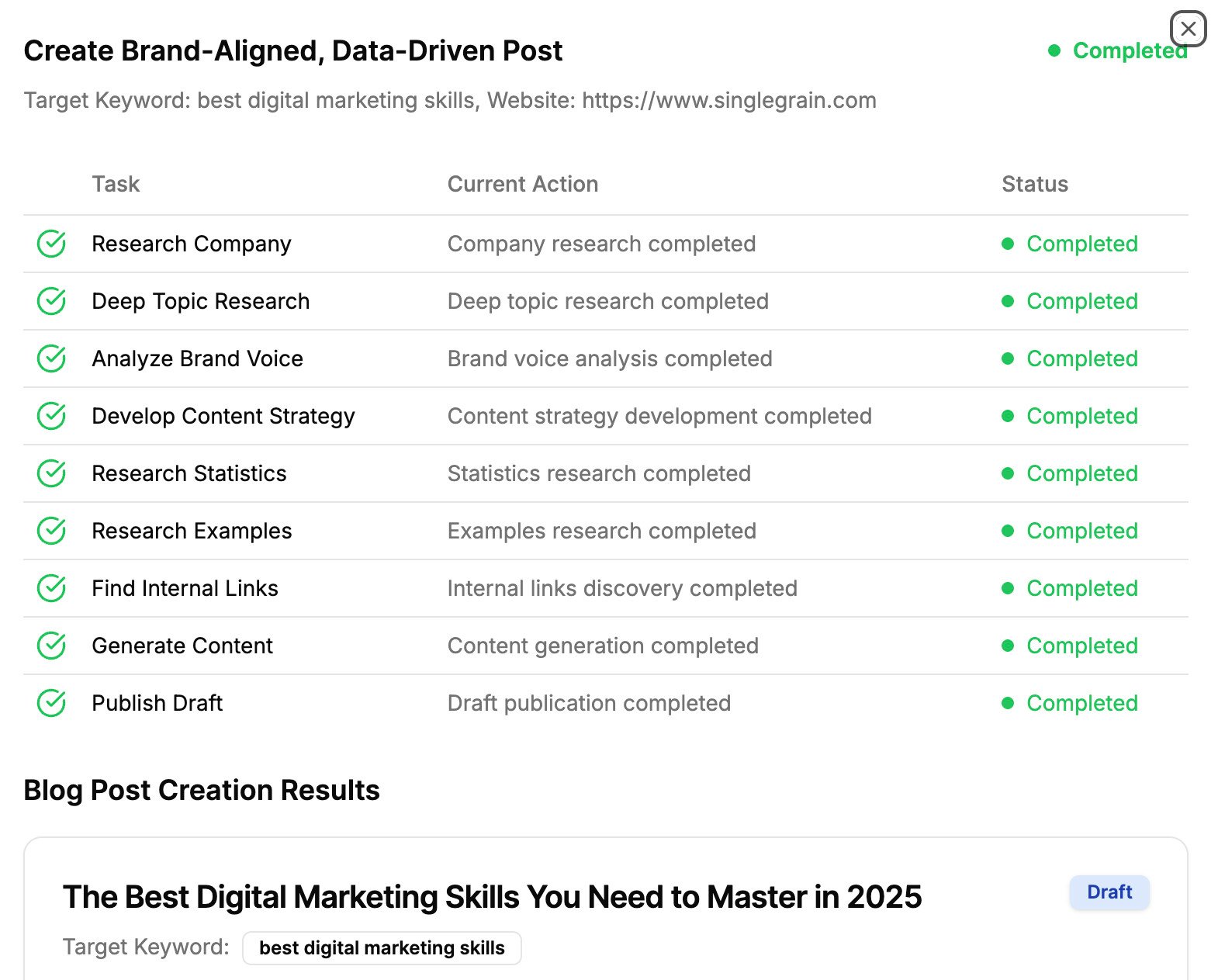If your organization struggles to reach sales goals, many strategies can help you bring more leads down the sales funnel. However, many businesses still rely on one-size-fits-all sales and marketing strategies that may not convert leads the way they should.
This is where account-based marketing (ABM) comes in. ABM aims to build relationships with target accounts likelier to engage with your brand.
How can organizations succeed at converting these accounts? ABM marketers must create a personalized marketing campaign based on their target account list and unique firmographics, interests, and needs.
Here’s why account-based marketing personalization is key for the success of your campaign and how to target your accounts with content and messages that resonate with them.
Key Takeaways
- ABM personalization relies on tailored content, sales messages, and customized experiences for each account or segment.
- Personalized ABM is a data-driven approach that results in more relevant content, stronger relationships with accounts, and better engagement rates, ensuring that organizations stand out from competitors.
- To start an ABM personalization strategy, create an ideal customer profile based on your target account list, use that data to personalize content, engage in multi-channel outreach, align sales and marketing teams, and measure your results.
TABLE OF CONTENTS:
The Fundamentals of ABM and Personalization
Before diving into why personalization is essential, it’s important to understand what ABM personalization is and how it works.
Traditional marketing efforts use generic messaging to cast a wide net of leads to increase brand awareness. ABM differs because it focuses on target accounts’ preferences, needs, and pain points. To address these accounts, marketers create relatable content, craft direct sales messaging, and create customized experiences for each account.
Personalized marketing encompasses email campaigns, website content, tailored ads, and sales outreach. Marketers rely on data and insights for each account to communicate their goals, pain points, challenges, and more. Sales and marketing messaging will offer a unique solution to these accounts. As a result, you’ll create a deeper connection with accounts, and they will have more trust in you.
Why Personalization in ABM Matters
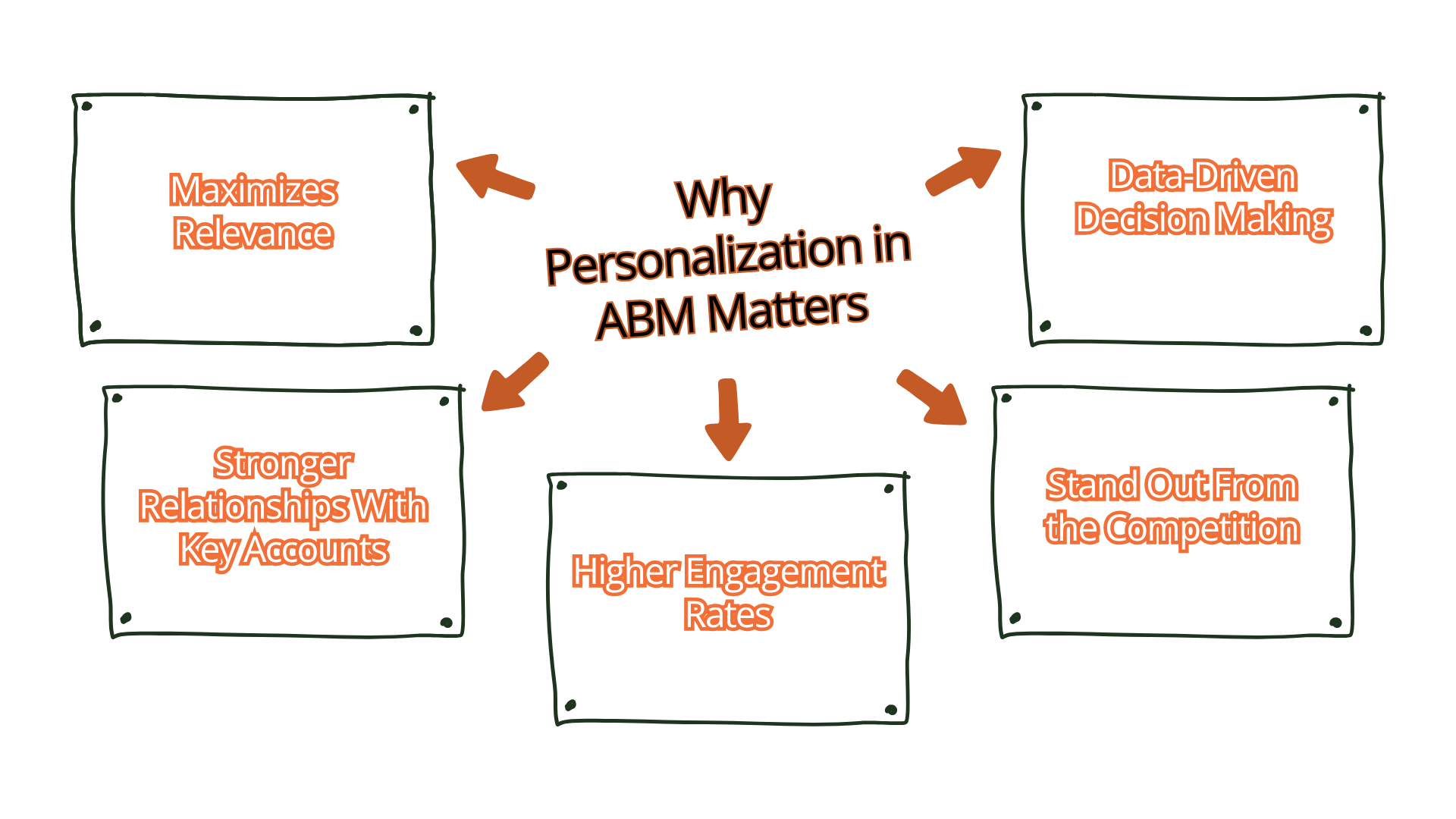
Personalized marketing and sales campaigns are among the most vital aspects of ABM. Tailored content captures more attention compared to generic marketing efforts. And since seven out of ten businesses invest in personalization, targeted marketing campaigns will make you more competitive. Here are other reasons ABM personalization is the best strategy to attract and convert target accounts.
Maximizes Relevance
In the B2B buying process, decision-makers are inundated with generic marketing messages rarely addressing their specific challenges. Personalization allows businesses to:
- Speak directly to the pain points of their target accounts.
- Provide solutions relevant to their industry, company size, and market position.
There’s a reason why marketing personalization works. In a study on brands attending webinars, 84% of respondents wanted relevant content, explicitly messaging that addresses current trends or challenges.
This is why personalized messaging addressing a specific pain point—such as improving supply chain efficiency—is far more likely to grab attention than a generic email about your company’s product features.
Stronger Relationships With Key Accounts
Personalized messaging helps you build trust and credibility with target accounts by demonstrating that you understand their unique roles and challenges. This approach humanizes your brand and fosters deeper connections, which is essential for closing deals.
Since organizations have multiple decision-makers, creating strong connections with these professionals can be challenging. Marketers can work through this hurdle by creating personalized content and messaging for each sales funnel stage to guide these decision-makers through the customer journey, ensuring they become loyal customers.
Higher Engagement Rates
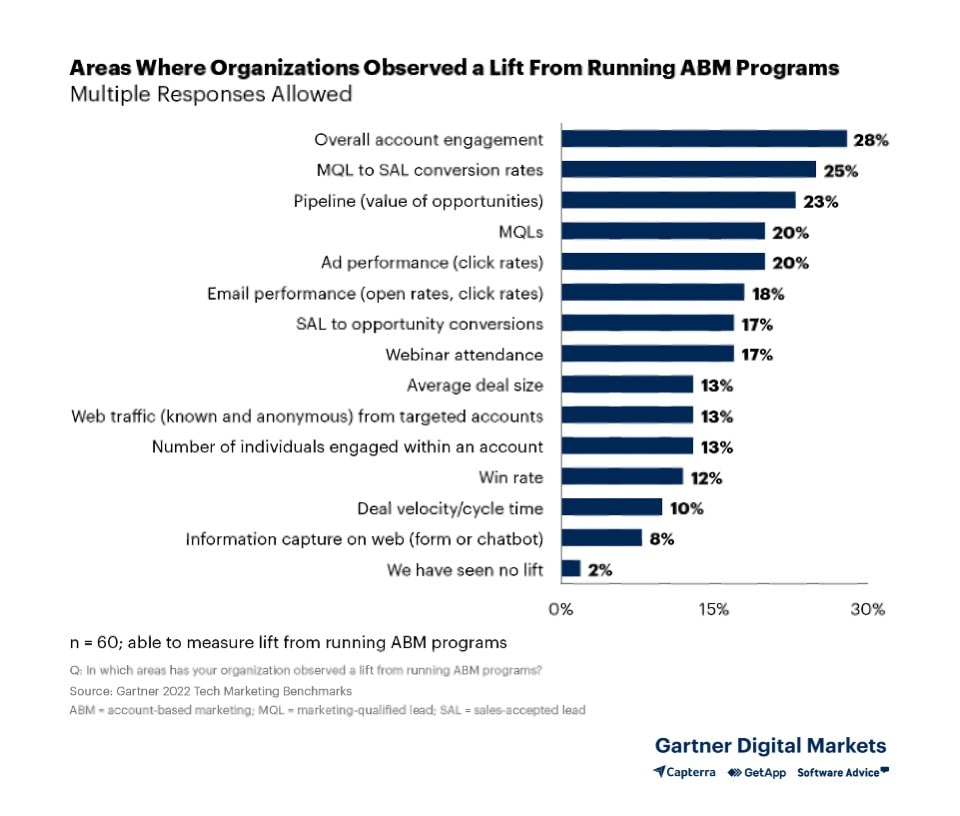
Source: Gartner Digital Markets
Personalized campaigns consistently outperform generic ones. In a Gartner study, 28% of respondents experienced overall account engagement after using ABM. And according to RollWorks, 75% of B2B marketers explain that ABM helped them find and engage accounts earlier in the buying process.
Personalized marketing tactics are more impactful, making it likelier that your target accounts will engage with your brand. Higher engagement rates directly translate to higher ROI in ABM, where the focus is on quality over quantity.
Stand Out From the Competition
Personalization sets you apart in a crowded market. When competitors rely on standard tactics, a personalized approach demonstrates a more profound commitment to understanding and serving the client. That’s why customized outreach can be the deciding factor between your brand and a competitor.
Data-Driven Decision Making
Personalization strategies rely on deep insights about your target accounts. As a result, B2B marketers must invest and practice data collection and analysis to better understand their most profitable accounts. This data-driven approach improves your marketing efforts and equips your sales team with valuable information to close deals more effectively.
How to Implement Personalization in an ABM Strategy
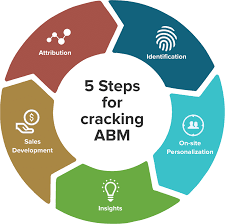
Source: Trendemon
Marketing personalization strategies are integral to ABM, but knowing how to begin a campaign can be tiresome. Follow these steps to create a robust personalized marketing strategy.
Step 1: Identify and Prioritize Target Accounts
The first step in ABM is selecting the accounts with the highest potential value. Start with firmographics such as revenue potential and the target companies you’re attracting. From here, gauge the accounts that align with your product offering. Once you identify these accounts, use personalized efforts to target them.
Collecting and analyzing this data DIY can be time-consuming and expensive. Fortunately, numerous ABM tools can analyze data efficiently and recommend high-value accounts, ensuring you waste no time and marketing dollars on leads that won’t convert.
Step 2: Create Account Profiles
Gather as much information as possible about your target accounts, including:
- Industry and market trends.
- Company size, structure, and revenue.
- Key decision-makers and their roles.
- Pain points and challenges.
- Goals and objectives.
Once you gathered and analyzed this data, you’ll want to create an ideal customer profile (ICP) to identify target accounts. If you have a robust ABM campaign and are segmenting your target companies, create an ICP for each segment.
Tools like LinkedIn Sales Navigator and ZoomInfo can help you build comprehensive profiles.
Step 3: Create Personalized Content
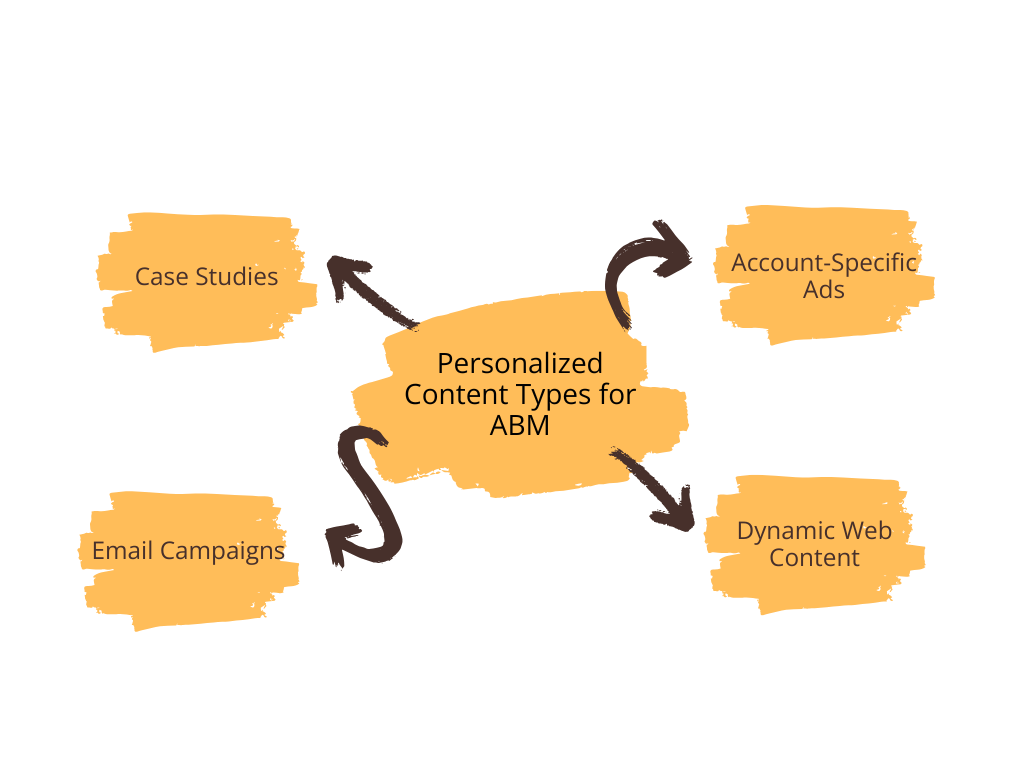
Now that you have the right insights and ICPs, it’s time to create content. Develop content that speaks directly to the needs and interests of your target accounts. Examples include:
- Custom case studies that showcase how you’ve solved similar challenges for other clients in the same industry.
- Tailored email campaigns that address specific pain points.
- Dynamic website content that adapts based on the visitor’s company or industry.
- Account-specific ads with messaging and imagery designed for the targeted account (we at Single Grain do this using Karrot ABM).
In addition to tailoring the messaging to their needs and pain points, always use the right tone that resonates with your accounts and their niche.
Step 4: Leverage Multi-Channel Outreach
Brands must be where their target accounts are to generate results from personalized campaigns. In other words, B2B marketers must use a multi-channel approach and create experiences that intrigue their key accounts.
Use a mix of email, social media, direct mail, and targeted ads to reach accounts where they are most active. Numerous ABM automation and AI tools integrate with various apps to scale marketing in one place. Ensure that your messaging is consistent yet tailored across these channels.
Step 5: Engage Sales Teams
ABM won’t be successful without a robust sales strategy. That’s because accounts move through the sales funnel, and marketing personalization customizes the buyer’s journey for each lead. As a result, sales teams play a critical role in ABM personalization, and marketing teams must align with sales professionals to convert leads.
Equip your sales and marketing teams with powerful tools like CRMs so they can collaborate on one platform. These tools must offer detailed account insights and personalized messaging templates to ensure they can effectively engage with decision-makers.
Step 6: Measure and Optimize
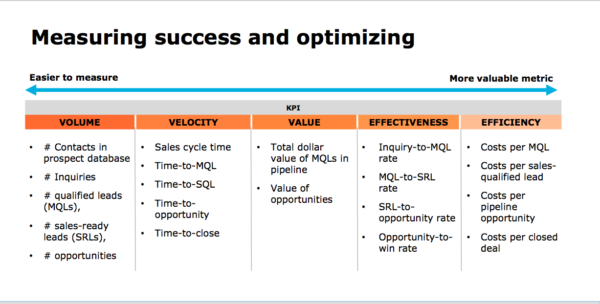
Source: Content Marketing Institute
Track engagement, conversion, and deal velocity metrics to ensure your ABM campaign delivers results. Use these insights to refine your approach and continuously improve the effectiveness of your campaigns.
Account-Based Marketing Personalization Is the Key to a Successful Campaign
ABM is a potent strategy to close more deals and accomplish sales goals. But marketers won’t achieve these results without account-based marketing personalization. Personalizing content, sales messaging, and outreach can make your campaign more relevant and have a better chance of engaging accounts.
To create a personalized ABM strategy, start by collecting data on your target accounts and using these insights to understand their needs and challenges. Craft a solution based on their pain points and use that in your sales and marketing messaging. Once more leads go down the sales funnel, measure metrics like engagements and conversion rates to ensure you’re making your ROI.
Have you invested in ABM personalization but are still not outperforming your competitors? It may be time to partner with a professional ABM marketing company.
If you’re ready to level up your account-based marketing personalization, Single Grain’s ABM experts can help!👇
Frequently Asked Questions on Account Based Marketing Personalization
-
What is account-based marketing?
Account-based marketing (ABM) is a strategy where marketing and sales teams use their resources toward target accounts. When choosing accounts, B2B marketers and sales professionals prioritize quality over quantity. They tailor campaigns to meet the unique needs of a select group of accounts most likely to convert customers.
-
Who should use ABM?
Any business will benefit from an ABM strategy since the goal is to tailor marketing and sales messaging to engage target accounts.
Organizations can use insights such as pain points and industry trends to apply them to a multi-channel campaign. Plus, when brands use customized elements, such as a tone of voice that correlates with an account’s brand, they can achieve better metrics, such as CTR, engagements, and conversions.
Since ABM is a lot of work, this campaign is best for businesses with the resources to handle these tailored strategies at scale. It works best for companies in specific industries, such as software and finance, focusing on building long-term relationships and securing large or complex deals.
-
What's the difference between ABM and lifecycle marketing?
ABM and lifecycle marketing are both potent strategies to engage leads and drive them down the sales funnel to become long-term customers. However, they differ in focus, objectives, and approach.
ABM is narrower and focused on converting a small number of high-value accounts. Lifecycle marketing has a more traditional approach to attracting a wider net of potential customers.
While both have their differences, organizations can use a combination of the two. For example, brands can first produce evergreen content and repurpose it to optimize growth among key accounts.
-
What are some ways to optimize my website for ABM?
Optimizing your website for ABM involves creating a personalized, engaging, and streamlined experience for your high-value target accounts. You can apply ABM to your website by creating landing pages for each account segment, running a retargeting campaign across all marketing channels, publishing content like case studies that will drive conversions, and adding a chatbot to your website.
Many CMS platforms like WordPress allow integrations with CRMs and sales tools to customize content for personalized campaigns. You can also continue to engage with existing customers by offering them gated content.
-
How can I align my sales and marketing teams for ABM?
Aligning your sales and marketing teams is critical for the success of any ABM strategy. Without collaboration, ABM efforts can become disjointed, leading to inefficiencies and missed opportunities.
First, ensure your sales and marketing teams share the same goals and metrics. Use firmographics and other data to create ICPs that both teams can use for targeting. Once you have ICPs, collaborate on personalized content with messages optimized for the sales funnel. Invest in CRMs and similar tools so both teams can collaborate and communicate in one place.
Related Video
For more insights and lessons about marketing, check out our Marketing School podcast on YouTube.






